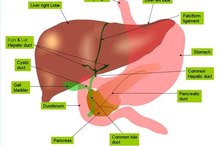Diffused Fatty Liver Disease
A diffuse fatty liver is the term used to describe a form of chronic liver disease caused by deposits of lipids surrounding liver cells. It's commonly associated with obesity and diabetes, and the symptoms may not show for years. The disease is asymptomatic in many patients, who are unaware of the condition until they visit a doctor for an unrelated issue. Fatty livers are detected by elevated liver enzymes in blood diagnostic tests.
Risk Factors
General risk factors of diffuse fatty liver disease are genetics and environment, but chances of developing the disease greatly increase with weight gain and obesity. Fatty liver disease normally affects people over the age of 40, but childhood obesity can lead to development in young adults. Additionally, the disease is more prevalent in women than in men.
Symptoms
What Is the Meaning of Hypermetabolic?
Learn More
Many patients are asymptomatic or attribute symptoms they have to other medical issues. Swelling of the liver is the primary symptom . Fatigue and malaise, common with the disease, are typically disregarded until more severe symptoms arise. Diffuse fatty liver disease can lead to cirrhosis, so onset of jaundice is a sign of serious liver problems.
Diagnosis
The condition is detected in blood exams. The presence of abnormally high amounts of aminotransferase enzyme is a sign of the disease. If the physician suspects liver disease, a biopsy is taken to confirm lab test results. Doctors may also test for Hepatitis to ensure that the condition is not caused by a viral infection.
Treatment
What Causes the Blood Glucose Level to Increase in Liver Damage?
Learn More
Treatment mostly centers on diet and weight control. Patients who are diabetic and obese may be prescribed insulin sensitivity treatments. Fatty deposits are also lowered through the use of fish oil with high omega-three fatty acids. In severe cases where cirrhosis has resulted in extreme liver damage, patients may undergo a liver transplant.
Prevention
Prevention is mainly achieved through weight maintenance. Patients with metabolism issues or diabetes are encouraged to limit the amount of lower fatty foods they ingest and to maintain an exercise regimen. Because insulin induces fatty acid production in the liver, carbohydrate intake should be lessened and monitored.
Related Articles
References
Writer Bio
Lysis is the pen name for a former computer programmer and network administrator who now studies biochemistry and biology while ghostwriting for clients. She currently studies health, medicine and autoimmune disorders. Lysis is currently pursuing a Ph.D. in genetic engineering.








